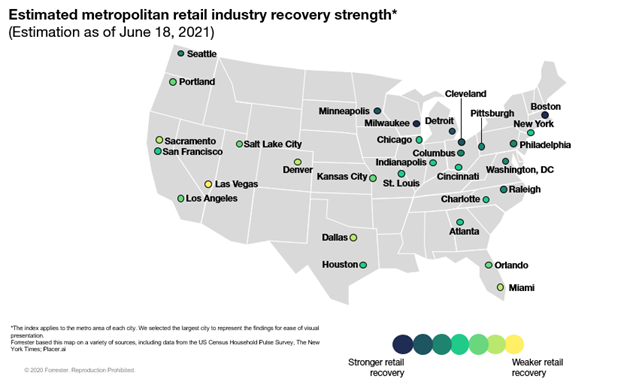Forrester’s US Retail Recovery Heat Map, June 2021 — Expected Income Loss Still High In Some Metros
Retail recovery is proceeding at different rates in various parts of the US. In May 2021, we adjusted our retail recovery heat map model to include the following factors:
- Economic sentiment — based on household expected loss of income in the next four weeks
- Change in cases — 14-day percentage change in cases
- Saturation of cases — cases per 100,000 people
- Vaccination rates — percentage of population that received their first vaccine
- Retail foot traffic — percentage change in daily retail foot traffic versus the same day two years ago
As of June 18, 2021, we see a lot to be happy about. For the 30 US metro areas we evaluated, new cases had fallen 21% over the prior two weeks, daily new cases were only four per 100,000 on average, and over 52% of metro area populations on average had received their first vaccine.
However, the percent of adults who expect someone in their household to have a loss in income in the next four weeks is still high, according to the US Census Household Pulse Survey. The US average for May 26, 2021, to June 7, 2021, was 12%. For adults in some cities, that was higher — for example, in Los Angeles (22%), New York (20%), and Houston (18%).
Based on our updated model, we are seeing a few trends:
- Retail recovery is increasing in the US Northeast and parts of the US Midwest. These areas include metro areas like Boston, Cleveland, Detroit, Milwaukee, and Minneapolis.
- Comparatively, retail recovery is lagging in parts of the US South and US West, including in metro areas such as Dallas, Las Vegas, and Miami.

If you would like to see the data behind these metrics or see more metropolitan areas, please contact your Forrester account representative, schedule an inquiry with me, or email Madeline Cyr, researcher, at mcyr@forrester.com.
